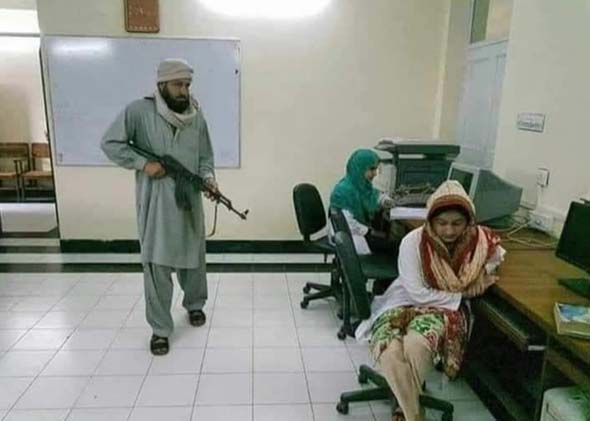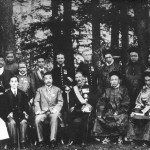IDR Blog
The Impact of Taliban Extremism on the Human and Mental Security of Women in Afghanistan!
Violence against women in Afghanistan is one of the most serious issues in human rights, which is very deep-rooted and widespread in this land. Therefore, Insecurity, abuse, mysterious rape, and violence against women and girls have reached their peaks these days under the shadow of the Taliban ruling in Afghanistan.All these efforts were made to realize Afghanistan women’s rights before the seizure of the Taliban group during the so-called era of democracy and republic. All efforts and dreams wasted and perished. So the severe restrictions of 2001 were once again imposed on women in all cities and regions in Afghanistan.The main question is, what are the causes of violence and abuse against women in Afghanistan? My article hypothesizes that the main reason for this can be traced to the culture, customs, attitudes, way of thinking, and way of life in Afghanistan in the broader meanings and concepts in the extremist thoughts and mentalities of religion and traditions.
Tribal and Traditional Jirgas in Afghanistan
These days, despite the economic, psychological, and mental challenges in Afghanistan, other than the Taliban violence against women and girls, husbands, brothers, and fathers are the main perpetrators of violence against women and girls in Afghanistan nowadays. But existing social and traditional behaviors, whether in the ruling system or in a tribal and customary structure such as jirgas (Ethnic and Tribal Pashtunism Council to locally solve any issue among people and tribes in Afghanistan), and councils give more legitimacy and seal to this type of violence against women and girls in Afghanistan. Women do have a small presence in such traditional and ethnic jirgas and councils, but even if they do, they do not have the right to speak so that their voices can be heard as needed.This article describes the various dimensions of violence, abuse against women, the lack of human and psychological security, and the effects and causes of such violence in Afghan society.
Traditionalism and Superstitiousness is the Source of Violence Against Women in Afghanistan
Afghanistan has the least tribal cohesion, unity, and solidarity in ethnic, religious, linguistic, and cultural aspects.Afghanistan’s history is full of darkness and conflicts. More than three decades of war and violence in Afghanistan has led to violent behavior in Afghan society. The people of the community are modeled on the culture of war in dealing with each other and most violent acts are committed for the smallest reasons. Such a behavior has made the society more fragile in Afghanistan.In Afghanistan society, customary and traditional laws are principles that ordinary citizens of Afghanistan adhere it. These laws apply to all aspects of life and are an important part of the cohesion of society. Thus anyone who disobeys customary and traditional laws in Afghan society is considered a criminal and is even sentenced to death by the ruling circles. Despite all these strict religious regulations, there is no place for women’s rights and equality in Afghan society, and there will not be. Therefore, one of the most vulnerable sections of Afghanistan society affected by violence and abuses is the women and girls of this war-torn country.
The Taliban’s return to power in 2021
When Afghanistan’s affairs were handed over to the Taliban on August 15, 2021, by traitorous politicians and fugitive President Ashraf Ghani, the Afghan National Army, National Police, and National Security forces disintegrated. With this turn of events, all the citizens of Afghanistan, especially women and girls, found that all their wishes and dreams had turned to despair and disappointment. Today, this situation negatively impacts the human, psychological, and mental security of women and girls, and it is difficult to find a way out of this crisis without the international community’s support. Therefore, these days, the Taliban often oppress, threaten, and torture women protesters in Afghanistan, forcing them to take silent pledges against the Taliban actions.But it is a fact that is buried inside Afghanistan today for fear of the Taliban torturing all people and women, and no one can report such cases to the world as they are. Prolonged conflicts and wars in Afghanistan have resulted in large number of civilian casualties, especially women and children.
Male Mahram
The Taliban regime between 1996 and 2001 has been a clear sign of violence and conflicts against women in Afghanistan. However, the official Taliban leadership ended in 2001 and was crushed by the United States invasion. Today, the Taliban has returned to the arena of power and violence against all Afghan citizens, especially women and girls. They now, practically, have full control over Afghanistan’s social, economic, educational, and political spheres and determine the fate of this land and 30 million people.Before the Taliban came to power, women in Afghanistan enjoyed greater rights and protection. But after the Taliban came to power, women were deprived of their rights and required by Taliban law to wear full headscarves and burqas. Education for girls and women is prohibited in most cities and provinces of Afghanistan, and women are not allowed to work. Nevertheless, another option that the Taliban recently added to its extremist law against Afghan women is “male Mahram” (a woman accompanied and escorted during the journey by her husband or any wise and mature Mahram of her first-degree relatives).Women without a male Mahram cannot travel or go to cities where these restrictions are idiotic and have no legal or Islamic basis.
Studies and Surveys Conducted on Afghanistan Women
Most sociological research on women in Afghanistan has been conducted in Latin by the United Nations and Human rights organizations in Afghanistan. Many sources include books such as “Women in Afghanistan under Taliban rule”, “Violence Against Women in Afghanistan,” etcetera. Published in 2008, it examines different types of violence against women in Afghanistan societies.All of these variables negatively affect the lives of girls and women in Afghanistan societies. So, none of these issues can be ignored. Therefore, to better understand the situation of this vulnerable and suffering group in Afghanistan, more detailed and in-depth studies of such complex political, social, cultural, religious, and traditional conditions are needed.Unfortunately, today, Ukraine’s war has had a negative impact on the humanitarian crisis in Afghanistan and has diverted the world’s attention from the Afghan crisis. The Afghan women issue is that, amid the Ukraine-Russia war, it gives the Taliban more opportunities to suppress people, ethnic, religious, and especially women minorities to achieve their aspirations and interests in Afghanistan by force and threat.
Lack of Health Facilities and women’s Health Conditions in Afghanistan
Unfortunately, the status of the health care system in Afghanistan is deplorable these days under the Taliban regime ruling, and all people, especially women and children, are the main victims of this dire situation in Afghanistan. Hospitals, clinics, and all health centers face a fragile situation of providing services to the citizens of Afghanistan, which the Taliban group has not done anything yet and has only announced and made false and repressive promises for the people of this country.Based on United Nations reports in Afghanistan, a quarter of children died before the age of five due to poor health in Afghanistan, and out of every 1000 births, 165 stillborn babies were born. Afghanistan ranks second in the world in terms of maternal mortality. Out of every 1000 births, 17 mothers died during their childbirth due to a lack of health facilities in Afghanistan’s cities and villages. References:(1994-report Development Human and Lacopino-1998: 71-79). Therefore, if the international community and the United Nations ignore the issues and the crisis in Afghanistan, we will see a tremendous humanitarian crisis in the history of humanity in the world. At that time, claims under the name of human rights will be nothing more than slogans and absurdities.
The Concept of Human and Psychological Security
Human and psychological security refers to a security that puts human beings at the center of conversations or security discussions. And it means real and pivotal support for all human beings in a way that leads to the full achievement and enjoyment of human freedoms. This case has seven main components, which include:Economic security or emancipation from poverty; Food security or access to food; Health security or access to health care and patients support; Environmental security or protection against pollution; Personal security or physical protection against torture, war, and criminal attacks; Social security or preservation of traditional cultures; Political security or political activities and freedoms. On this basis, it can be said that human and psychological security is, in fact, the same confidence and sense of security that human beings have in terms of preserving life, dignity, maternal and spiritual rights, worldly belongings, and enjoying their fundamental rights and freedoms.
The Unknown Fate of Alia Azizi
Finally, This is an issue that all the people of Afghanistan, especially women, children, and girls, are facing today with these serious and bone-chilling challenges and problems. No one in Afghanistan now has the immunity of life, economy, or even freedom of expression, and the Taliban have hardened all these human dreams of women and people of Afghanistan, and the people are suffering from all kinds of mental and psychological problems inside Afghanistan.Despite challenges and difficulties Afghan people faced due to mismanagement and violence by the Taliban against the people of Afghanistan. Many women came to the streets and cities of Afghanistan and protested against the extremist ideology of the Taliban. The majority of the demonstrators were detained by the Taliban, threatened and tortured illegally in Taliban prisons, and most of them are still in detention. The Taliban repress, torture, detain and kill protestor citizens such as women, officials, and government employees, and most of the time, the Taliban never admit their crimes. However, the Taliban abducted Ms. Alia Azizi, the manager of Herat Prison in western Afghanistan, in the previous government. There is no news about Ms. Alia Azizi’s fate.





